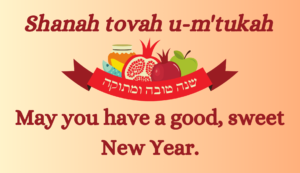Rosh Hashanah means “head, or beginning, of the year.” It is the Jewish New Year, and is the first of
the Yamim Noraim (“Days of Awe”), the High Holy Days.
Learn more at ReformJudaism.org Learn more at MyJewishLearning
Greetings of the Season
Traditional Jewish greetings for this time of year reflect our hopes and prayers for a good, sweet year ahead. The general greeting for the entire season is Shanah Tovah (שנה טובה ), or L’shanah Tovah, which means “[have a] good year.” The word u-m’tukah ( ומתוקה ) means “and sweet.” Shanah tovah u-m’tukah or L’shanah tovah u-m’tukah is how we say, “May you have a good, sweet New Year.”

Another greeting is Shanah tovah tikateivu v’teichateimu (שנה טובה תכתבו ותחתמו). This means, “May you be written and sealed for a good year.”
From Rosh Hashanah to Yom Kippur, it is customary to say G’mar chatimah tovah ( גמר חתימה טובה ), which means “A good, final sealing,” translated idiomatically as “May you be inscribed [in the Book of Life] for good.”

The shofar is traditionally sounded at the conclusion of the morning service. Blow the Shofar yourself
with these apps: Apple, Google Play
Music can move our hearts and connect us to themes of the High Holy Day liturgy, to one another, and
to God. Music for the High Holidays
Challah (traditional bread) eaten for Rosh Hashanah is round, symbolizing the eternal cycle of life.
The challah is traditionally dipped in honey, symbolizing hope for a sweet New Year. The same is done
with apples, which are made even sweeter with the addition of honey.
More recipes to enhance your holiday: Reform Judaism, The Jewish Grandparents Network
Rosh Hashanah blessings for your home: Reform Judaism
PJ Library High Holidays at Home, The Jewish Grandparents Network, Rosh Hashanah videos from BimBam
The Jewish Grandparents Network, Jewish Boston’s Teen Guide to Rosh Hashanah